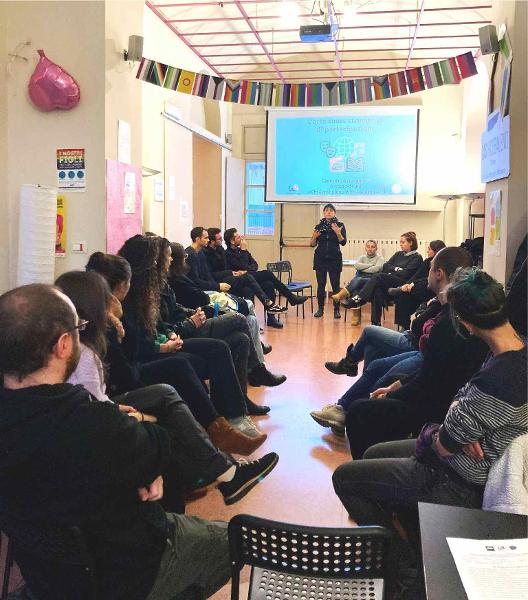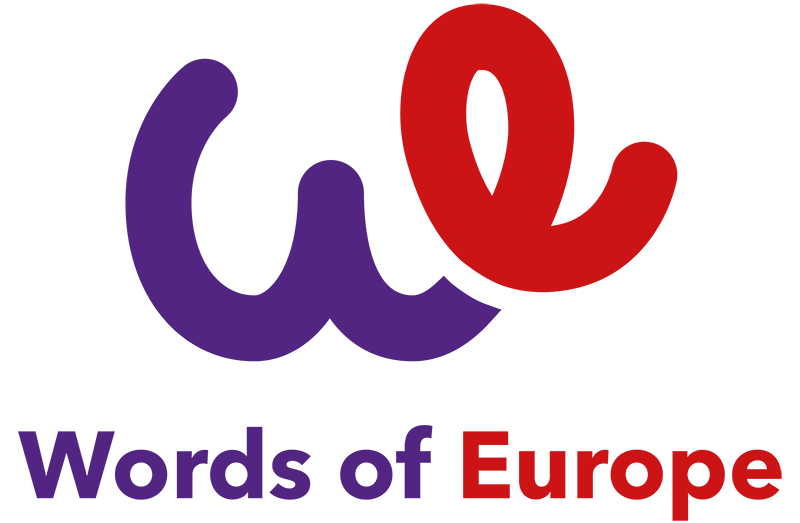Exploring art & culture for democratic participation: Insights from Words of Europe project's workshops.
The report on the realization of the participatory model has two main objectives: firstly, it seeks to identify recurring themes and patterns in the WP6 events conducted, summarizing the outcomes regarding the diverse artistic content offered and its impact on citizen expression. Additionally, it will consider lessons gleaned from comparing these events with similar ones organized by other organizations within different projects. Secondly, the report provides guidelines and practical advice for future WP7 events based on the feedback received.

Within the scope of WP6 in the Words of Europe project, several local workshops were conducted. These workshops aimed to develop participatory methods that can encourage citizen expression, which will be implemented in the subsequent phase of the project (WP7). The primary objective was to explore the utilization of art and culture as mediums for fostering democratic participation.
Indeed, setting up a workshop or artistic event during which European issues can be tackled can be a suitable way of facilitating the appropriation of the topic by participants and inviting them to express themselves in return. This innovative form of participation can also be an opportunity to target groups who usually feel excluded or not interested.
This report has two main objectives. Firstly, it seeks to identify recurring themes and patterns in the events conducted, summarizing the outcomes regarding the diverse artistic content offered and its impact on citizen expression. Additionally, it will consider lessons gleaned from comparing these events with similar ones organized by other organizations within different projects. Secondly, the report provides guidelines and practical advice for future WP7 events based on the feedback received.
I) Workshops review
The workshops carried out by partners revealed two main types of approach to the civic dimension:
-
Exposing content related to citizenship to participants in artistic forms such as drawings, posters, films, etc., with the aim of eliciting reactions, fostering debate, or even inspiring participants to create their own artistic works inspired by the exhibition.
-
Encouraging participants to engage in one or more art workshops centered around a socio-political issue. Through their artistic creations, participants will convey their unique perspectives on the issue, and they will be invited by the organizer to share a brief statement about their work.
Discussions about EU-related topics often delve into technicalities, making them less accessible to many. However, beginning with a genuine emotional response or engaging in an artistic workshop can help bridge this gap by tapping into participants' personal sensitivities. From this starting point, a more natural transition can be made toward encouraging their civic expression.
A) Reaction to exhibition
The idea is to create a space similar to an exhibition, where visitors wander around and observe different works of art. A workshop facilitated by Arci and UCCA emphasized the significance of selecting a strategically well-visited location. While the content of the exhibition is open-ended, it should facilitate a connection with civic themes associated with the EU. Association community has used a variety of media (movies' posters, movies' teasers, cartoons, photos, drawings, paintings...).
All these productions were representing something about the EU (migration, Brexit, borders, but also some positive aspects like youth international mobility, diversity...). Similarly, the « Be a Citizen Pamphleteer workshop, part of the Re-imagining Citizenship project organized by Longhborough University in 2018, featured a collection of illustrated protest pamphlets from all over the world. The purpose of such workshops is to encourage participants to engage with the exhibition and elicit reactions. Association Community provided the public with the opportunity to place "emojis" around the artworks, expressing their emotions. Additionally, it is possible to have a blank page near the artwork where participants can write down questions and reactions.
This practice offers the advantage of indirectly engaging all potential visitors with the exhibition, as they can view the reactions of previous participants. This can encourage them to share their own opinions as well. However, it's important to consider that making previous reactions visible in this manner may also cause inhibition for some participants who do not naturally align with the mainstream reactions. Another possibility, inspired by the toolkit designed by the Grand Palais Museum in Paris2, is to display representations of works of art expressing civic concerns, and invite participants to guess the message of each one. The organizer can then gather responses and offer correct answers to participants as they exit the exhibition (or alternatively, assume that every answer is correct!).
In the second phase, the exhibition should allow space for participant expression. The « Be a Citizen Pamphleteer » workshop encouraged participants to craft their own pamphlets either advocating for or against a subject of their choosing. They could base their pamphlets on a text, a slogan, a drawing, or other creative elements. Association Community organized one or more debates with participants following the exhibition, allowing them to discuss the reactions they had to various pieces of art. This approach enabled the artworks encountered during the exhibition to provoke contemplation among participants, aiding in their understanding and engagement with the themes conveyed.
B) Artist-led creation
An artist-led workshop provides another way to connect art with civic participation. The artist, inspired by the project, plays a pivotal role in explaining and demonstrating to participants how artistic creation inherently serves as a form of civic expression. The workshop organized by Arci and UCCA emphasized the importance of engaging local artists rather than hosting one-off events with renowned artists that lack long-term impact. For instance, in 2013, the ADRIC association conducted a visual arts workshop featuring a local artist dedicated to ecological transition. The objective was to provide participants with the opportunity to create paintings exploring concepts of citizenship and secularism, utilizing collage techniques and recycled materials. Through the process of composing these artworks, various dimensions of the issues converged and interplayed, naturally fostering discussion and debate around them.
Participants collaborate directly with the artist in workshops that take the form of large-scale collaborative works. A prime example is the collective fresco, where the artist initiates a large-scale pictorial creation around a theme and guides successive participants as they add their contributions. This approach allows for flexible attendance over time while still fostering the development of a shared project. Another possibility is to organize a simultaneous co-creation event, similar to the approach taken by the Altera association. Their working groups devised the concept of a collective happening or a musical performance led by a guest artist. In addition to directly involving all participants in the same activity and the civic themes it explores, this type of workshop offers the advantage of being more accessible to disabled audiences. Rather than being left to engage with an activity independently, they can participate in the collective practice alongside others.
C) Creative Workshops on Relevant Topics
A third form of workshop focuses on the diversity and creativity of the participants, offering a variety of mini-workshops, each centered on a different form of artistic expression. For instance, Subjective Value association encouraged groups of 15-year-old students to collaborate in small teams of 4 or 5, choosing the artistic activity that appealed to them the most.
They then produce a piece of artwork addressing a social issue. The range of small-scale workshops encompasses various forms of artistic expression, including collage, origami, video, painting, drawing, sculpture, music, or even 3D modeling. After completing their artwork, participants are encouraged to present it, thereby engaging in citizen reflection and discussing the relevance of the chosen art form for expressing their ideas.
It is also conceivable to reverse the relationship between civic expression and artistic creation while maintaining a similar approach. This is precisely what the Faktor terminal association proposed. Firstly, they facilitated a discussion among participants about the issues that concerned them. Subsequently, participants were encouraged to materialize the various ideas they had formulated by crafting pins.
II) Guidelines and useful tips
-
✔ Content originating from the EU should be open to discussion and respectful of participants' pre-existing opinions. A workshop that appears to function as a lecture to rectify public ignorance risks alienating participants from the issues at hand. Instead, inviting participants to engage should be regarded as an acknowledgment of their civic viewpoints, rather than an attempt to indoctrinate or correct them.
-
✔ Presenting an exhibition or a performance before inviting participants to create their own small artistic productions is an effective method for conveying the workshop's concept. Not only does the demonstration introduce the issues at hand, but it also provides examples of how to express them through art. This approach serves as a means to alleviate inhibitions.
-
✔ If you're concerned that the complexity of the EU might deter participants from engaging in the workshop, it's a wise approach to begin by encouraging them to simply react to political content (especially when presented in artistic form). Introducing an activity that prompts participants to explain their reactions or propose alternatives will gradually guide them towards formulating their own personalized civic proposals.
-
✔ Promoting activities centered around a local artist is an effective strategy for adding familiarity to a workshop that might otherwise feel disconnected. Similarly, involving an artist who is dedicated to a specific cause can foster dialogue with participants about the relevant issues and offer guidance on artistic production.
-
✔ Organizing a collective artistic activity involving all participants (such as a fresco, happening, or collective performance) is a highly effective method of maximizing engagement. However, it's crucial to complement this with a dedicated timeframe or mechanism that enables each individual or small group to formulate citizen proposals.
-
✔ Presenting multiple mediums of artistic expression within the same workshop, as opposed to a single form, immediately engages participants' sensibilities. Although more challenging, this format encourages participants to delve deeper into their artistic production and the message they aim to convey through it.
TESTING OF THE PARTICIPATORY MODEL
Based on the previous events, workshops and consultations, a common format of participation will be realised. At least 15 pilots of the model will be organised involving at least 380 participants from 7 countries. JEF Europe will organise an international pilot in Madrid with participants from Spain, Belgium, Malta, France, Germany, Italy. UCCA organises pilots in Carbonia-Iglesias, Napoli, Benevento, Avellino, Bari, Santeramo, Lecce, Ferrara, Modena, Bologna. Arci Solidarietà onlus, Altera APS, Community, Ligue de l'enseignement, Subjective Values Foundation, Faktor Terminal will organise pilots in Rome, Turin, Arques, Paris, Budapest with participants from Italy, France and Hungary. The main pillars of the participatory method will be the fruition of artistic contents previously selected (films, shows, etc. part of the common European heritage) and the realisation of participatory moments (debates, collection of ideas and proposal, etc.) around the European keywords identified in WP1. The format will be shaped according to the participatory model co-constructed in WP4. Through this participatory activity the European keywords of WP1 will be confirmed or denied and will be linked to concrete proposals for the future of the EU.
FINAL COLLECTION OF QUESTIONS FOR CANDIDATES
During the pilots, participants will keep collecting questions for candidates of European elections of 2024 (or newly elected MEPs). The questions are sent via email to at least 500 candidates with diverse political backgrounds and coming from at least 15 different countries. Answers will be shared through the website and the social networks of W.E. project.
FINALISATION OF THE MODEL AND MULTIPLYING TRAINING SESSIONS
Based on the realised experiences, the participatory model will be finalised by partners in a dedicated toolkit. Each partner will organise at least 1 info-sessions or internal training to further disseminate the model to other CSOs or to its local branches/circles/sections.
ONLINE UPLOAD OF PROPOSALS
The proposals of citizens collected around the European keywords during the events will be uploaded on the platform of the Conference on the Future of Europe or on other e-democracy platforms identified by the consortium.


